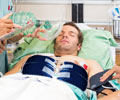New guidelines were proposed to deal with the in-flight emergency of cardiac arrest in a passenger or crew member on a plane journey.

Approximately 3 billion people worldwide traveled by commercial air transport in 2016. A calculation based on the number of passengers transported shows that between 1 out of 14,000 to 1 out of 50,000 passengers will experience acute medical problems during a flight.
While cardiac arrest accounts for just 0.3% of all in-flight medical emergencies, it is responsible for 86% of in-flight events resulting in death. Recently, the Star Wars actress Carrie Fisher died following a cardiac arrest she suffered on a plane journey to Los Angeles.
Despite this high fatality rate of in-flight cardiac arrest (IFCA), so far, no guideline for IFCA exists that provides specific treatment recommendations. Thus, a DGLRM task force was created to develop a guideline for the treatment of in-flight cardiac arrest based on clinical and investigational expertise in this area.
Several main recommendations have been developed, which include:
- Emergency equipment provided and its location should be mentioned in the pre-flight safety announcement
- An electrocardiogram (ECG) should be available for patients with cardiac arrest; automated external defibrillators (AEDs) have this function available and many planes now have an AED on board. The guidelines recommend that this equipment should be available on all planes.
- It is very important for the crew to request help as soon as possible by an onboard announcement after identification of a patient with cardiac arrest. The announcement should state there has been a suspected cardiac arrest and also the location of the emergency equipment.
- Two-person CPR is considered optimum (as it is better quality) and should be performed if possible; the crew should be trained regularly in basic life support, ideally with a focus on CPR in aircraft.
- The plane should be diverted immediately if the patient has a return of spontaneous circulation.
He and his team will now begin raising awareness of the guideline by directly contacting individual airlines and asking them to incorporate it into their emergency procedures.
Advertisement
Source-Eurekalert














